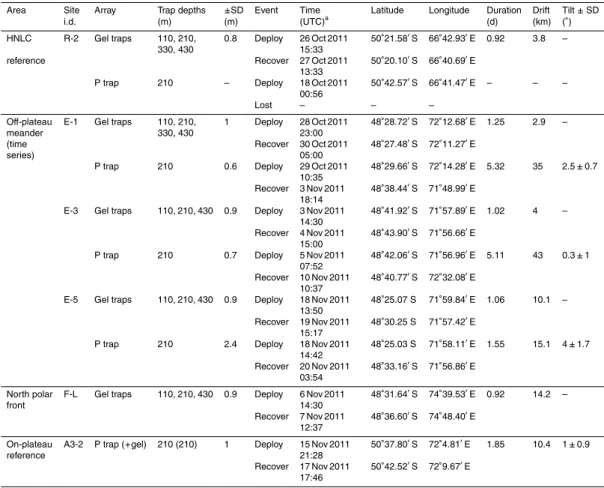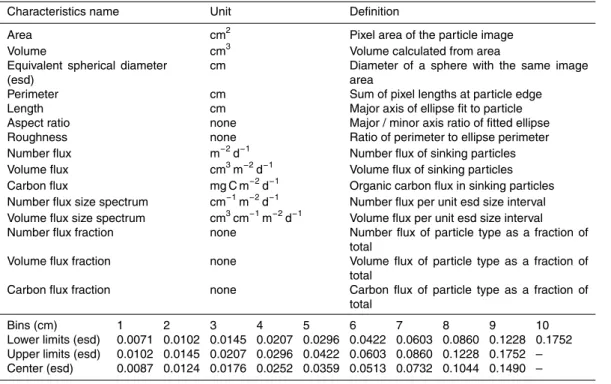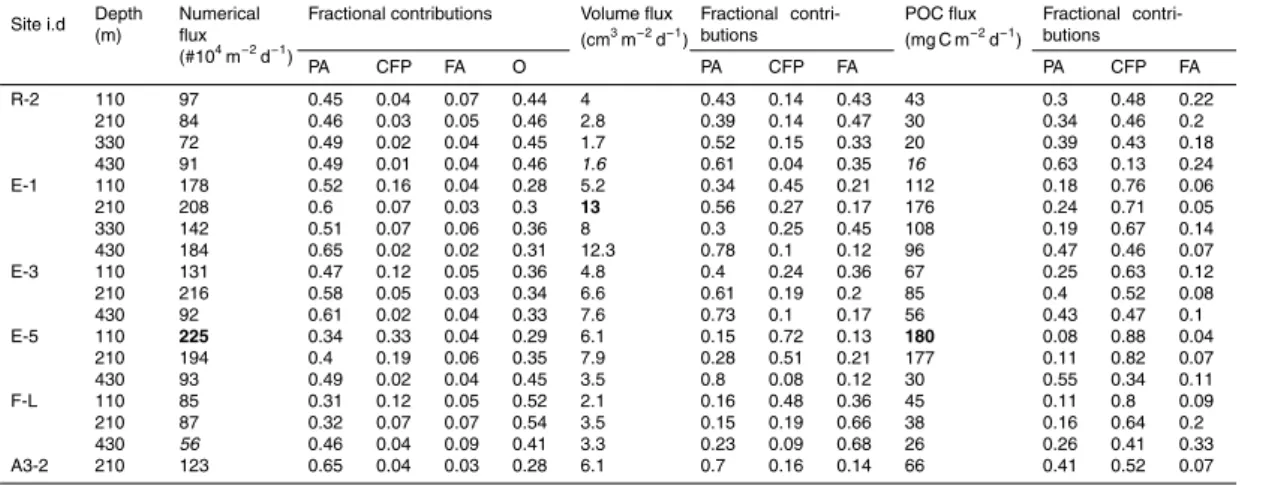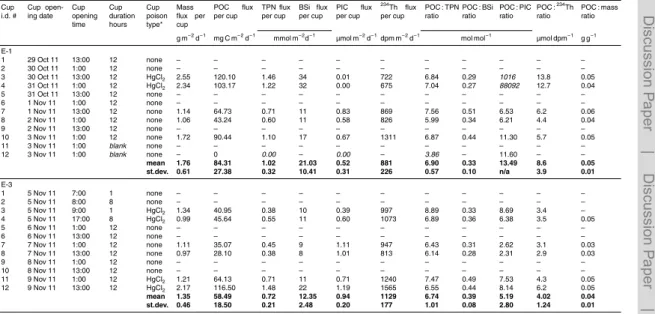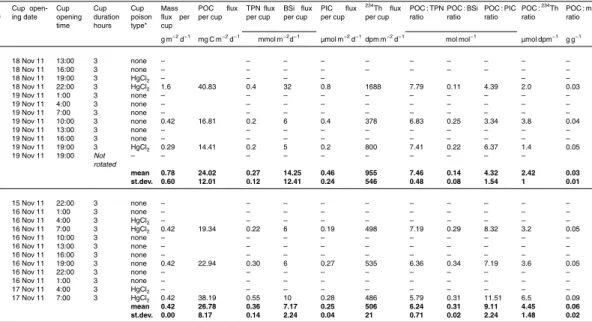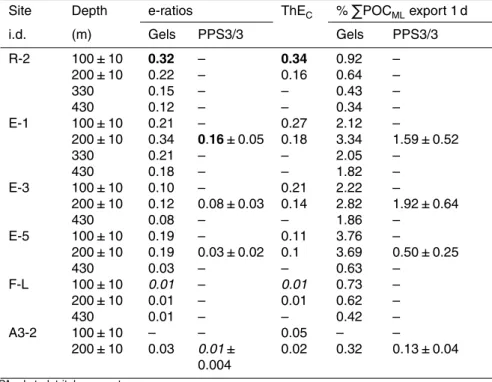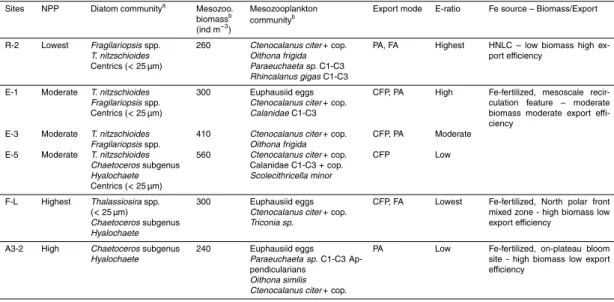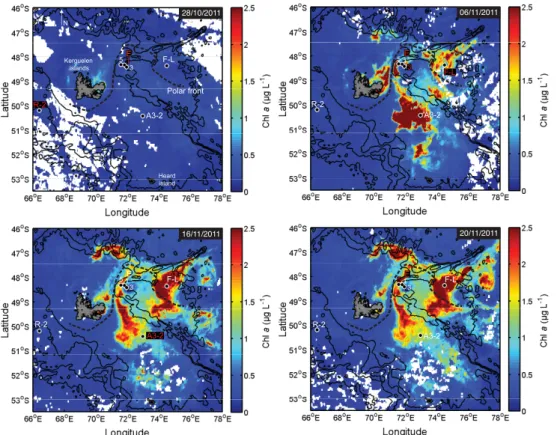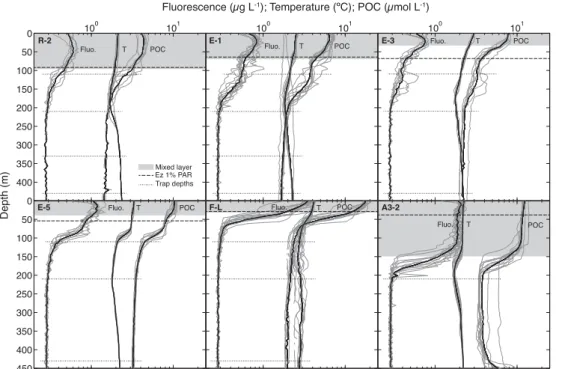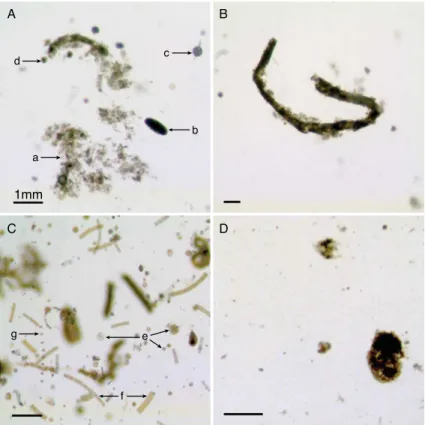BGD
11, 13623–13673, 2014
The importance of sinking particle types
to carbon export
E. C. Laurenceau et al.
Title Page
Abstract Introduction
Conclusions References
Tables Figures
◭ ◮
◭ ◮
Back Close
Full Screen / Esc
Printer-friendly Version Interactive Discussion
Discussion
P
a
per
|
Discus
sion
P
a
per
|
Discussion
P
a
per
|
Discussion
P
a
per
|
Biogeosciences Discuss., 11, 13623–13673, 2014 www.biogeosciences-discuss.net/11/13623/2014/ doi:10.5194/bgd-11-13623-2014
© Author(s) 2014. CC Attribution 3.0 License.
This discussion paper is/has been under review for the journal Biogeosciences (BG). Please refer to the corresponding final paper in BG if available.
The relative importance of phytoplankton
aggregates and zooplankton fecal pellets
to carbon export: insights from
free-drifting sediment trap deployments in
naturally iron-fertilised waters near the
Kerguelen plateau
E. C. Laurenceau1,2, T. W. Trull2,3, D. M. Davies2, S. G. Bray2, J. Doran4, F. Planchon5, F. Carlotti6, M.-P. Jouandet6, A.-J. Cavagna7, A. M. Waite4, and S. Blain8,9
1
CSIRO-UTAS Quantitative Marine Sciences PhD Program, Institute for Marine and Antarctic Studies, University of Tasmania, Private Bag 129, Hobart Tasmania 7001, Australia
2
Antarctic Climate and Ecosystems Cooperative Research Centre, University of Tasmania, Private Bag 80, Hobart Tasmania 7001, Australia
3
BGD
11, 13623–13673, 2014
The importance of sinking particle types
to carbon export
E. C. Laurenceau et al.
Title Page
Abstract Introduction
Conclusions References
Tables Figures
◭ ◮
◭ ◮
Back Close
Full Screen / Esc
Printer-friendly Version Interactive Discussion
Discussion
P
a
per
|
Discus
sion
P
a
per
|
Discussion
P
a
per
|
Discussion
P
a
per
|
4
UWA Oceans Institute, The University of Western Australia (M470), 35 Stirling Highway, Crawley Western Australia 6009, Australia
5
Laboratoire des Sciences de l’Environnement Marin (LEMAR), Université de Brest, CNRS, IRD, UMR6539, IUEM; Technopôle Brest Iroise, Place Nicolas Copernic, 29280 Plouzané, France
6
Mediterranean Institute of Oceanography (MIO), Aix-Marseille Université, CNRS-IRD, 13288 Marseille, CEDEX 09, France
7
Vrije Universiteit Brussel, Analytical and Environmental Geochemistry dept., Brussels, Belgium
8
CNRS, UMR7621, LOMIC, Observatoire Océanologique, 66650 Banyuls-sur-Mer, France 9
UPMC Université Paris 06, UMR7621, LOMIC, Observatoire Océanologique, 66650 Banyuls-sur-Mer, France
Received: 18 August 2014 – Accepted: 18 August 2014 – Published: 19 September 2014
Correspondence to: E. C. Laurenceau (emmanuel.laurenceau@utas.edu.au)
BGD
11, 13623–13673, 2014
The importance of sinking particle types
to carbon export
E. C. Laurenceau et al.
Title Page
Abstract Introduction
Conclusions References
Tables Figures
◭ ◮
◭ ◮
Back Close
Full Screen / Esc
Printer-friendly Version Interactive Discussion
Discussion
P
a
per
|
Discus
sion
P
a
per
|
Discussion
P
a
per
|
Discussion
P
a
per
|
Abstract
The first KErguelen Ocean and Plateau compared Study (KEOPS1), conducted in the naturally iron-fertilised Kerguelen bloom, demonstrated that fecal material was the main pathway for exporting carbon to the deep ocean during summer (January– February 2005), suggesting a limited role of direct export via phytodetrital
aggre-5
gates. The KEOPS2 project re-investigated this issue during the spring bloom initiation (October–November 2011), when zooplankton communities may exert limited grazing pressure, and explored further the link between carbon flux, export efficiency and dom-inant sinking particles depending upon surface plankton community structure. Sinking particles were collected in polyacrylamide gel-filled and standard free-drifting sediment
10
traps (PPS3/3), deployed at six stations between 100 and 400 m to examine flux com-position, particle origin and their size distributions. Results revealed an important con-tribution of phytodetrital aggregates (49±10 % and 45±22 % of the total number and
volume of particles respectively, all stations and depths averaged). This high contribu-tion dropped when converted to carbon content (30±16 % of total carbon, all stations 15
and depths averaged), cylindrical fecal pellets representing then the dominant fraction (56±19 %).
At 100 and 200 m depth, iron and biomass enriched sites exhibited the highest car-bon fluxes (maxima of 180 and 84±27 mg C m−2d−1; based on gel and PPS3/3 trap
collection respectively), especially where large fecal pellets dominated over
phytodetri-20
tal aggregates. Below these depths, carbon fluxes decreased (48±21 % decrease in
average between 200 and 400 m), and mixed aggregates composed of phytodetritus and fecal matter dominated, suggesting an important role played by physical aggrega-tion in deep carbon export.
Export efficiencies determined from gels, PPS3/3 traps and 234Th disequilibria
25
(200 m carbon flux/net primary productivity), were negatively correlated to net primary productivity with observed decreases from ∼0.2 at low-iron sites to ∼0.02 at
BGD
11, 13623–13673, 2014
The importance of sinking particle types
to carbon export
E. C. Laurenceau et al.
Title Page
Abstract Introduction
Conclusions References
Tables Figures
◭ ◮
◭ ◮
Back Close
Full Screen / Esc
Printer-friendly Version Interactive Discussion
Discussion
P
a
per
|
Discus
sion
P
a
per
|
Discussion
P
a
per
|
Discussion
P
a
per
|
this negative relationship. Our work emphasizes the need to consider detailed plank-ton community structure to accurately identify the controls on carbon export efficiency, which appear to include small spatio-temporal variations of ecosystem structure.
1 Introduction
Physical and biological processes occuring in the surface ocean generate a vast
diver-5
sity of particles. These particles represent potential vehicles to export organic carbon to the deep ocean where a small fraction can eventually be sequestered in the sedi-ments. This process, known as the “biological carbon pump” (BCP) influences the level of atmospheric carbon dioxide and thus the global climate system (Volk and Hoffert, 1985; Lam et al., 2011).
10
Primary production in the euphotic layer builds a stock of phytoplankton cells. If their concentration and stickiness are high enough (Jackson, 1990), these can collide, at-tach and form large phytodetrital aggregates (Burd and Jackson, 2009; McCave, 1984); with those reaching sizes greater than 0.5 mm known as “marine snow” (Alldredge and Silver, 1988). Alternatively, phytoplankton cells can be tightly packed into dense fecal
15
pellets through zooplankton grazing (Silver and Gowing, 1991). Because of their large size and high density respectively, phytodetrital aggregates and fecal pellets are major constituents of the downward flux, and several studies have found either fecal pellets (Fowler and Knauer, 1986; Pilskaln and Honjo, 1987; Bishop et al., 1977; Wassmann et al., 2000; Ebersbach and Trull, 2008; Cavagna et al., 2013) or large organic
ag-20
gregates (Turner, 2002; Alldredge and Gotschalk, 1989; De La Rocha and Passow, 2007; Jackson, 1990; Burd and Jackson, 2009), to be the dominant vectors of carbon to depth.
Because grazing causes losses of organic carbon by respiration (Michaels and Sil-ver, 1988; Alldredge and Jackson, 1995), direct export via the sinking of phytodetrital
25
BGD
11, 13623–13673, 2014
The importance of sinking particle types
to carbon export
E. C. Laurenceau et al.
Title Page
Abstract Introduction
Conclusions References
Tables Figures
◭ ◮
◭ ◮
Back Close
Full Screen / Esc
Printer-friendly Version Interactive Discussion
Discussion
P
a
per
|
Discus
sion
P
a
per
|
Discussion
P
a
per
|
Discussion
P
a
per
|
exported directly via phytodetrital aggregates are yet unclear and their determination would considerably improve the predictions of the efficiency of the BCP in varying con-ditions. The volume fraction of phytodetrital aggregates vs. fecal pellets in the total flux and their volume to carbon content ratio, select the dominant carbon export mode; these relative contributions depend on numerous parameters including primary
pro-5
ductivity, biomass, interactions between primary producers and heterotrophic commu-nities (Michaels and Silver, 1988), physical fragmentation, microbial decomposition, coprophagy and the velocity at which particles settle (Turner, 2002).
The Southern Ocean contains the largest High Nutrient Low Chlorophyll (HNLC) area of the world ocean and is an essential player in global biogeochemistry
(Sig-10
man and Boyle, 2000). In these waters, abundant macronutrients (silicic acid, nitrate and phosphate) can fuel primary production given available light and sufficient iron, a limiting micronutrient (de Baar et al., 1995; Martin, 1990). The Kerguelen plateau offers the opportunity to study the functioning of the BCP in a naturally iron-fertilised region (Blain et al., 2007). The first KErguelen Ocean and Plateau compared Study
15
(KEOPS1), demonstrated that most of the sinking flux collected in polyacrylamide gel sediment traps was derived from copepod fecal detritus (intact or degrading pellets and fecal aggregates) and reported limited evidence for phytodetrital aggregates formed by direct flocculation of phytoplankton cells (Ebersbach and Trull, 2008). Number and vol-ume fluxes were dominated by aggregates but they represented a small fraction of the
20
total carbon flux, owing to their low volume to carbon content ratio. Several natural and artificial iron-fertilization experiments conducted at the same time of the year but in dif-ferent locations in the Southern Ocean (e.g. SAZ-sense study and SOFeX), displayed similar export modes relying mainly on fecal matter (Bowie et al., 2011; Ebersbach et al., 2011; Coale et al., 2004; Lam and Bishop, 2007). In contrast, other artificial and
25
BGD
11, 13623–13673, 2014
The importance of sinking particle types
to carbon export
E. C. Laurenceau et al.
Title Page
Abstract Introduction
Conclusions References
Tables Figures
◭ ◮
◭ ◮
Back Close
Full Screen / Esc
Printer-friendly Version Interactive Discussion
Discussion
P
a
per
|
Discus
sion
P
a
per
|
Discussion
P
a
per
|
Discussion
P
a
per
|
These variations among studies may reflect the time-varying aspects of export. In his review of Southern Ocean ecosystem contribution to carbon export, Queguiner (2013) suggests that from the onset of a bloom to its decline and subsequent export event, phytoplankton, and to a lesser extent zooplankton communities, are subject to sev-eral rapid successions. The complexity of the processes is also reflected by the past
5
30 years of empirical and modelling studies attempting to relate deep carbon export variations to surface productivity (Eppley and Peterson, 1979; Suess, 1980; Wass-mann, 1990; Guidi et al., 2009). In general, the ratio between export and production in the surface ocean is low (<5–10 %; Buesseler, 1998), but decoupling associated with high export events (e.g. high latitude blooms), or even negative relationships have been
10
noted (Maiti et al., 2013; Buesseler, 1998; Ebersbach et al., 2011; Lam and Bishop, 2007). This highlights the complexity of food web structure and its multiple controls on carbon export (Wassmann, 1998; Michaels and Silver, 1988).
In the present study we test the hypothesis that direct export via phytodetrital ag-gregates occurs during the early stage of the Kerguelen naturally iron-fertilized bloom,
15
when zooplankton communities present in the water column are not fully developed. We further explore the relative export abilities of each carbon export mode (i.e. phy-todetrital aggregates vs. fecal pellets), by looking at their variation with depth and over time, and their links to spatio-temporal variations of plankton communities.
We collected sinking particles in free-drifting polyacrylamide gel and standard
sedi-20
ment traps. Gel traps allowed the collection of intact natural particles as they sank in the water column (Ebersbach and Trull, 2008; Jannasch et al., 1980; McDonnell and Buesseler, 2010), and thus gave a direct “picture” of the sinking flux at the depth of trap deployment. Image analysis of particles embedded in gels provided particle statistics (e.g. number and volume fraction of each category of particle), and conversion from
25
BGD
11, 13623–13673, 2014
The importance of sinking particle types
to carbon export
E. C. Laurenceau et al.
Title Page
Abstract Introduction
Conclusions References
Tables Figures
◭ ◮
◭ ◮
Back Close
Full Screen / Esc
Printer-friendly Version Interactive Discussion
Discussion
P
a
per
|
Discus
sion
P
a
per
|
Discussion
P
a
per
|
Discussion
P
a
per
|
from234Th depletion method (Planchon et al., 2014). Then, to test our main hypothe-sis, the relative contribution of each category of particles was linked to the amount of carbon effectively exported, to determine which one led the carbon export.
2 Material and methods
2.1 The KEOPS2 study
5
The second KErguelen Ocean and Plateau compared Study (KEOPS2) was conducted onboard the R.V.Marion Dufresneover and downstream of the Kerguelen plateau, from the 8 October to the 30 November 2011 (as described in detail in Blain, 2014). Sinking particle flux and composition were assessed by the use of free-drifting sediment traps deployed at six stations, inside and outside the naturally iron-fertilised area, in waters
10
with varying biomass levels (Fig. 1). Combination of sediment trap collection with vol-ume to carbon conversion factors allowed to determine preferential modes of carbon export (Ebersbach and Trull, 2008; Ebersbach et al., 2011).
2.2 Water column properties and biomass at each station
In addition to trap-derived measurements, POC concentrations were estimated in the
15
water column using a WET Labs C-Star (6000 m) transmissometer (660 nm wave-length and 25 cm path wave-length), linked to a conductivity-temperature-depth (CTD) sys-tem (Seabird SBE-911+CTD). Xmiss transmissometer data (%) were converted to POC concentrations (µmol L−1), following a calibration based on in situ POC measure-ments from Niskin bottles. A Seapoint Chelsea Aquatracka III (6000 m) chlorophyll
flu-20
BGD
11, 13623–13673, 2014
The importance of sinking particle types
to carbon export
E. C. Laurenceau et al.
Title Page
Abstract Introduction
Conclusions References
Tables Figures
◭ ◮
◭ ◮
Back Close
Full Screen / Esc
Printer-friendly Version Interactive Discussion
Discussion
P
a
per
|
Discus
sion
P
a
per
|
Discussion
P
a
per
|
Discussion
P
a
per
|
Figure 2 shows water column properties and biomass at each site. The HNLC ref-erence station R-2 located outside the fertilised area was characterised by a relatively deep mixed layer (96 m), low net primary productivity (euphotic zone 1 % PAR inte-grated NPP =135±6 mg C m−2d−1; Cavagna et al., 2014), low surface chlorophyll
(chlorophylla mixed layer average=0.6 µg Chl aL−1), and biomass (mixed layer
inte-5
grated POC=4.7 g C m−2). Stations E-1, E-3 and E-5 were located in an eddy-like, bathymetrically trapped recirculation feature in deep waters east of the Kerguelen is-lands (stationary meander of the polar front), with a mixed layer depth varying from 33 m (E-3) to 70 m (E-1). These stations had moderate NPP (523±55, 686±97 and
943±113 mg C m−2d−1 respectively), chlorophyll a (0.8, 0.7 and 1.1 µ g Chl a L−1 10
respectively), and biomass (5.3, 3 and 4.8 g C m−2
respectively). They were used as a time series assuming a pseudo-lagrangian evolution (d’Ovidio, 2014). F-L was the only station located north of the polar front and exhibited the shallowest mixed layer (31 m). A3-2 was the second visit to the on-plateau bloom reference station of KEOPS1 and had the deepest mixed layer (149 m). F-L and A3-2 displayed the highest NPP
15
(3.4±0.1 and 1.9±0.2 g C m−2d−1respectively), chlorophylla(3 and 1.8 µg ChlaL−1
respectively) and biomass (6.2 and 20.4 g C m−2
).
2.3 Sediment trap preparation, deployments and recovery
Two different types of trap were deployed during KEOPS2. Bulk fluxes of particulate organic carbon (POC), total particulate nitrogen (TPN), biogenic silica (BSi), particulate
20
inorganic carbon (PIC), particulate iron (PFe; data shown in Bowie et al., 2014) and thorium 234 (234Th) were estimated using PPS3/3 traps (Technicap, La Turbie, France). A PPS3/3 trap consists of a single cylindrical trap with an internal conical funnel at its base with a collection area of 0.125 m2 that collects samples into a carousel of 12 cups. During KEOPS2, these traps were deployed for a maximum period of 6 days.
25
Cups were filled with brine with a salinity of∼52 psu, made by freezing filtered (0.2 µm
BGD
11, 13623–13673, 2014
The importance of sinking particle types
to carbon export
E. C. Laurenceau et al.
Title Page
Abstract Introduction
Conclusions References
Tables Figures
◭ ◮
◭ ◮
Back Close
Full Screen / Esc
Printer-friendly Version Interactive Discussion
Discussion
P
a
per
|
Discus
sion
P
a
per
|
Discussion
P
a
per
|
Discussion
P
a
per
|
(1 g L−1) as a biocide (as detailed in Table 4). No poison was added to the cups used for trace metal studies (Bowie et al., 2014).
To examine sinking flux characteristics (particle type, number and size), intact par-ticles were also collected in cylindrical polyacrylamide gel-filled sediment traps with a collection area of 0.011 m2. These deployments lasted less than two days to not
5
overload the gels (Table 1). Polyacrylamide gels were prepared following the method developed by Lundsgaard (1995), modified as described in Ebersbach and Trull (2008). Each category of trap was deployed on separate arrays, except at A3-2 (combined deployment; Table 1). The arrays had broadly the same design consisting of a surface float sustaining a mooring line where the traps were fixed at different depths. PPS3/3
10
traps were fixed at 210 m and one to four gel traps, depending on the station, were fixed at 110, 210, 330 and 430 m. Wave-induced motions were dampened by an elastic to keep the traps at a constant depth (Trull et al., 2008). Pressure sensors mounted on the deepest gel trap and PPS3/3 trap on most of the arrays confirmed very small vertical motions during the deployments with depth standard deviations ranging from 0.6 m at
15
E-1 to 2.4 m at E-5 (Table 1). The average trap drift speed of 8.5±5 cm s−1 was in the
range of horizontal velocities determined by drogued drifter trajectories (Zhou et al., 2014). Inclinometers recorded little tilts of the mooring lines (from 0.3±1◦ at E-3 to
a maximum of 4±1.7◦at E-5), guaranteeing minimum perturbation of particle collection
due to hydrodynamic conditions. No particular difficulties were encountered during trap
20
BGD
11, 13623–13673, 2014
The importance of sinking particle types
to carbon export
E. C. Laurenceau et al.
Title Page
Abstract Introduction
Conclusions References
Tables Figures
◭ ◮
◭ ◮
Back Close
Full Screen / Esc
Printer-friendly Version Interactive Discussion
Discussion
P
a
per
|
Discus
sion
P
a
per
|
Discussion
P
a
per
|
Discussion
P
a
per
|
2.4 Chemical analysis
Protocols used for particulate organic carbon (POC), total particulate nitrogen (TPN), particulate inorganic carbon (PIC) and biogenic silica (BSi) analyses are described in Trull et al. (2008).234Th flux analysis is detailed in Planchon et al. (2014).
2.5 Image analysis
5
Within a few hours after recovery, each gel was photographed onboard against a laser etched-glass grid of 36 cells (each 14 mm×12.5 mm) at a magnification of×6.5 using
a light field transmitted illumination and a Zeiss Stemi 2000-CS stereomicroscope cou-pled to a Leica DFC-280 1.5 million pixel digital camera and Leica Firecam software on an Apple iMac G4 computer. Observations at higher magnification (from×10 to×50) 10
confirmed particle identifications when needed.
Pictures of incomplete grid cells, with inequally distributed particles or large zoo-plankton were removed from the analysis to avoid bias. Ten grid cells per gel (total of 180 pictures) were selected randomly. The average sum of the surface analysed per gel was 15.7±0.7 cm2corresponding to 14.3±0.7 % of the trap collection area. 15
Particles collected in gels (Fig. 3) were phytodetrital aggregates (PA), cylindrical fe-cal pellets (CFP), oval fefe-cal pellets, fefe-cal aggregates (FA) and diatoms in the form of chains (e.g. the pennate Fragilariopsis spp.) or single cells (e.g. the centric Tha-lassiosira spp.). A few zooplankton specimens were collected (less than 10 by gel), and were mostly represented by copepods (adult and copepodite stages),
appendicu-20
larians, foraminifera and radiolarians. Phytodetrital aggregates were loose and green, while fecal aggregates contained dense brown material. Most cylindrical fecal pellets had sharp edges and relatively constant diameters but some were tapered along their length and had blurred edges composed of unpacked fecal material or attached phy-todetritus (Fig. 3B).
25
cylin-BGD
11, 13623–13673, 2014
The importance of sinking particle types
to carbon export
E. C. Laurenceau et al.
Title Page
Abstract Introduction
Conclusions References
Tables Figures
◭ ◮
◭ ◮
Back Close
Full Screen / Esc
Printer-friendly Version Interactive Discussion
Discussion
P
a
per
|
Discus
sion
P
a
per
|
Discussion
P
a
per
|
Discussion
P
a
per
|
drical fecal pellets and fecal aggregates. Fecal aggregates were distinguished from phytodetrital aggregates by their inclusions of dense fecal matter. A fourth category, oval fecal pellets, was rare (less than one pellet per image in total), and its contribution to the flux was assumed negligible. Particle characteristics were then determined by conversion to binary images, with threshold levels adjusted manually on each picture to
5
ensure a minimum alteration of particle areas. The average alteration of particle area estimated on a subsample was an increase of 21.6±7 % (n=169) for particles having
irregular shapes (e.g. aggregates sensu lato including phytodetrital and fecal aggre-gates), and an increase of 11.6±7 % (n=44) for cylindrical fecal pellets. Cylindrical
fecal pellet and aggregate areas were systematically corrected for this overestimation.
10
Pictures were analysed with the US National Institutes of Health free software Image J. Typical shapes of each category of particle was determined manually on a sub-sample of particles. Matlab routines using specific sets of shape descriptors were then applied to all images to identify and separate each category of particle. Because aggre-gates had similar complex shapes, fecal aggreaggre-gates were isolated manually from
phy-15
todetrital aggregates, based on the assumption that fecal matter is brown and denser than biologically unprocessed phytoplankton (Ebersbach et al., 2011). Tests conducted on a large sample showed that 93.4 % (n=397) of cylindrical fecal pellets and 67.2 % (n=171) of fecal aggregates were correctly identified by the set of shape descriptors chosen.
20
An area cut off applied at 0.004 mm2 (0.07 mm equivalent spherical diameter) re-moved all “fake particles” deriving from small gel imperfections and glass-grid or mi-croscope lens cleanliness. This cut offremoved 38 % of the total number of particles (mostly spurious particles and small single cells) but represented only a loss of 5.2 % of the total area of particles in the images, introducing a negligible bias.
25
BGD
11, 13623–13673, 2014
The importance of sinking particle types
to carbon export
E. C. Laurenceau et al.
Title Page
Abstract Introduction
Conclusions References
Tables Figures
◭ ◮
◭ ◮
Back Close
Full Screen / Esc
Printer-friendly Version Interactive Discussion
Discussion
P
a
per
|
Discus
sion
P
a
per
|
Discussion
P
a
per
|
Discussion
P
a
per
|
finding the minimum root of the polynomial:
4r2
−P r+A=0 (1)
whereP is the perimeter and A is the projected area of the aggregate. The lengthL was calculated from the projected area and radius using the formula:
L=A/2r (2)
5
The volume was then calculated from the radius and length.
The conversion from volume to carbon content was done by using different ratios and relationships depending on the particle considered. Figure 4 shows the relationship between carbon content and particle volume for different algorithms from the literature and those selected in this study. Based on values published by González and Smetacek
10
(1994), the volume of cylindrical fecal pellets was converted to their organic carbon con-tent using a ratio of 0.036 mg C mm−3(Line 2), as an average value for copepod (Line
1), and euphausiid fecal pellets (Line 3). For fecal aggregates, we used the power rela-tionship between POC content and aggregate volumeV, POC (µg)=1.05V(mm3)0.51, based on the fractal decrease of carbon content with size and determined empirically
15
by Alldredge (1998) for fecal marine snow (Line 4). The volume of phytodetrital aggre-gates was converted to carbon content using also a power relationship determined by Alldredge (1998) for diatom marine snow, POC (µg)=0.97V(mm3)0.56(Line 5), assum-ing aggregates composed of phytoplankton not biologically processed. In contrast to Ebersbach and Trull (2008; Line 6), very small particles (aggregates composed of few
20
cells and large single cells) were included in the category of phytodetrital aggregates and their volume to carbon conversion was done using the same relationship (Line 5). Particle number and volume fluxes are presented in the Sect. 3 as a function of size spectra. All particles were binned in 10 size classes spaced logarithmically to give the best representation of the whole size range (Jackson et al., 1997, 2005). To avoid bias,
25
BGD
11, 13623–13673, 2014
The importance of sinking particle types
to carbon export
E. C. Laurenceau et al.
Title Page
Abstract Introduction
Conclusions References
Tables Figures
◭ ◮
◭ ◮
Back Close
Full Screen / Esc
Printer-friendly Version Interactive Discussion
Discussion
P
a
per
|
Discus
sion
P
a
per
|
Discussion
P
a
per
|
Discussion
P
a
per
|
3 Results
3.1 Particles collected in polyacrylamide gel-filled sediment traps
3.1.1 Particle number, projected area and volume fluxes
Despite variations of deployment duration among sites exceeding 80 % (between 0.9 and 5.3 days; Table 1), an observation of raw images (Fig. 5) gives a broad preliminary
5
indication on flux differences in term of particle abundance (e.g. low fluxes at R-2 and F-L, and higher at E-stations and A3-2). The lowest particle numbers, projected particle area and volume fluxes were collected at R-2 and F-L (Table 3 and Fig. 6), with particle volume fluxes of 2.5±1 and 3±0.7 cm3m−2d−1at R-2 and F-L respectively (all depths
averaged). In contrast high fluxes were collected at E-stations with an average volume
10
flux of 7.5±3 cm3m−2d−1(all E-stations and depths averaged). Station A3-2 presented
also a relatively high flux of 6.1 cm3m−2d−1.
Phytodetrital aggregates dominated in number at most stations and depths (49±10 %
of the total number of particles for all stations and depths averaged). Particles not se-lected automatically as phytodetrital aggregates, cylindrical fecal pellets or fecal
aggre-15
gates (“others” on Table 3), represented the second largest numerical fraction (38±8 %)
but less than 9 % of the total projected particle area, and thus were assumed neg-ligible in volume fluxes. Phytodetrital aggregates dominated also the volume fluxes (45.3±22 %; all stations and depths averaged), with a maximum of 70 % at A3-2.
How-ever, volumes of cylindrical fecal pellets collected at E-5 (44±33 %; all depths aver-20
aged) and volumes of fecal aggregates collected at F-L (57±18 %; all depths averaged)
represented the highest fractions at these stations.
Projected area fluxes at all stations and depths (Fig. 6), showed a clear attenuation of the total flux between 210 and 430 m (loss of 38±21 % in average) with a
maxi-mum attenuation of 74 % at E-5 (Fig. 6a). A decrease of the flux of cylindrical fecal
25
BGD
11, 13623–13673, 2014
The importance of sinking particle types
to carbon export
E. C. Laurenceau et al.
Title Page
Abstract Introduction
Conclusions References
Tables Figures
◭ ◮
◭ ◮
Back Close
Full Screen / Esc
Printer-friendly Version Interactive Discussion
Discussion
P
a
per
|
Discus
sion
P
a
per
|
Discussion
P
a
per
|
Discussion
P
a
per
|
phytodetrital), except at R-2 where a general flux attenuation was observed (all particle categories), and only a small increase of phytodetrital aggregates at 430 m.
Fluxes at E-stations at 110 and 210 m decreased with time between E-1 and E-3, followed by a strong increase of cylindrical fecal pellet flux at E-5 (Fig. 6c).
3.1.2 Number and volume flux spectra
5
Smallest particles were the most numerous at every site and depth (Fig. 7). Particle numbers decreased more than three orders of magnitude for a one order of magni-tude increase in size (0.008 to 0.07 cm), leading to slopes values around−3, so in the
range expected for particle size distribution (PSD) in natural waters (−2 to−5;
Buonas-sissi and Dierssen, 2010; Guidi et al., 2009) Phytodetrital aggregates, representing the
10
largest fraction of total particles, followed broadly the same spectra. Most cylindrical fecal pellets and fecal aggregates were middle-sized (ESD of 0.015–0.1 cm) with max-imum abundances in the range 0.015–0.03 cm. E-5 presented the highest abundance of large fecal pellets (0.025 to 0.035 cm) with values exceeding 2×107 and 7×106
# m−2d−1cm−1at 110 m and 210 m respectively.
15
At all sites, most of the volume flux of phytodetrital aggregates was carried by middle sized particles (ESD of 0.01–0.03 cm), due to the small contribution of large aggre-gates to the total number. Middle-sized and large cylindrical fecal pellets and fecal ag-gregates (ESD of 0.03–0.07 cm) carried most of the volume flux, but again the largest particles did not bring the highest contribution due to their rarity relative to smaller
par-20
ticles (except at R-2 where the the largest cylindrical fecal pellets and fecal aggregates contributed significantly to the volume flux).
The most notable change of the number flux spectra with depth was observed for middle-sized cylindrical fecal pellets at E-stations, for which a decrease in number was generally combined with an increase in size. E-1 presents the best illustration with most
25
BGD
11, 13623–13673, 2014
The importance of sinking particle types
to carbon export
E. C. Laurenceau et al.
Title Page
Abstract Introduction
Conclusions References
Tables Figures
◭ ◮
◭ ◮
Back Close
Full Screen / Esc
Printer-friendly Version Interactive Discussion
Discussion
P
a
per
|
Discus
sion
P
a
per
|
Discussion
P
a
per
|
Discussion
P
a
per
|
3.1.3 POC flux from image analysis
The lowest carbon fluxes were estimated at R-2 and F-L (Table 3), with values of 27±
12 and 36±10 mg C m−2d−1 respectively (all depths averaged). The highest carbon
fluxes were observed at E-stations (107±33 mg C m−2d−1, all E-stations and depths
averaged) with a maximum value of 180 mg C m−2d−1 at E-5, 110 m. A3-2 presented
5
a moderate carbon flux of 66 mg C m−2d−1at 210 m.
Cylindrical fecal pellets carried most of the carbon flux at all stations and depths, with an average fractional contribution of 56±19 % (Table 3). This was particularly true at
E-stations where fecal pellets drove on average 63±17 % of the carbon flux (maximum
of 88 % at E-5, 110 m) and at F-L (62±20 %, all depths averaged). However, at several 10
stations, a transition was observed at 430 m where phytodetrital aggregates brought the largest fractional contribution with 63, 47 and 55 % at R-2, E-1 and E-5 respectively. Fecal aggregates carried generally a small fraction of the carbon flux with an average of 13±8 % (all stations and depths), but their contribution tended to increase with depth
(e.g. 24 % and 33 % at 430 m at R-2 and F-L respectively).
15
3.2 Biogeochemical fluxes collected in PPS3/3 traps
Bulk fluxes from PPS3/3 traps are reported in Table 4. The highest mass, POC,234Th and TPN fluxes were collected at E-stations. POC fluxes decreased over time from 84±27 at E-1, to 58±18 at E-3, and 24±12 at E-5 mg C m−2d−1. A3-2 presented
a POC flux of 27 mg C m−2d−1. An average 234Th activity of 988
±127 dpm m−2d−1 20
was recorded at E-stations with a maximum of 1129±177 dpm m−2d−1 at E-3. 234Th
fluxes are detailed in Planchon et al. (2014). Over all sites, BSi fluxes were very high (7±2 to 21±10 mmol BSi m−2d−1), suggesting the large contribution of diatoms
to the phytoplankton community. Conversely, very low particulate inorganic carbon (PIC) fluxes (3 to 4 orders of magnitude lower than POC fluxes) suggested the
lim-25
BGD
11, 13623–13673, 2014
The importance of sinking particle types
to carbon export
E. C. Laurenceau et al.
Title Page
Abstract Introduction
Conclusions References
Tables Figures
◭ ◮
◭ ◮
Back Close
Full Screen / Esc
Printer-friendly Version Interactive Discussion
Discussion
P
a
per
|
Discus
sion
P
a
per
|
Discussion
P
a
per
|
Discussion
P
a
per
|
except E-5 (7.5) which also displayed the lowest POC : BSi ratio (0.1). At E-stations POC :234Th and POC : mass ratios decreased over time (POC :234Th ratios from 8 at E-1 to 2.1 µmol dpm−1 at E-5; POC : mass ratio from 0.05 at E-1 to 0.03 g g−1 at E-5), suggesting an attenuation of export fluxes combined with a degradation of sink-ing particles. A3-2 displayed POC :234Th and POC : mass ratios of 4.4 µmol dpm−1and
5
0.06 g g−1respectively. In general, no consistent differences in fluxes could be resolved between poisoned and unpoisoned cups.
3.3 POC flux comparisons and export efficiencies
POC fluxes determined from gel images (using particle volume to carbon content con-version factors) were in the same range of values as those determined from particle
10
collection in PPS3/3 with maximum differences at a same station never exceeding one order of magnitude (Tables 3 and 4). POC fluxes from PPS3/3 were systematically lower than those derived from image analysis (in average 57±22 % less).
E-ratios calculated as the ratio of POC fluxes from gel image analysis to 1 % PAR integrated net primary productivity (Cavagna et al., 2014; Table 5), indicated a high
15
export efficiency at R-2 and E-1 (0.2±0.08 and 0.23±0.07 respectively, all depths
averaged), intermediate at E-3 and E-5 (0.1±0.02 and 0.13±0.09 respectively, all
depths averaged), and very low at F-L (0.01±0.0, similar value at all depths) and
A3-2 (0.03). E-ratios derived from POC fluxes estimated from PPS3/3 traps showed lower values but following the same trend: E-1>E-3>E-5>A3-2. Export efficiencies
20
derived from234Th disequilibria, ThEC(Planchon et al., 2014), are shown in Table 5 for comparison, and are discussed in the next section.
According to calculations based on gel trap POC flux and transmissometer POC concentration estimates (Fig. 2), E-stations exported the largest percentage of their mixed layer-integrated POC (ΣPOCML) per day (2.4±1 %, all E-stations and depths
25
averaged) with the maximum observed at E-5 (2.7±1.8 %, all depths averaged) and
values of 2.3±0.7 % and 2.3±0.5 % at E-1 and E-3 respectively (all depths averaged).
BGD
11, 13623–13673, 2014
The importance of sinking particle types
to carbon export
E. C. Laurenceau et al.
Title Page
Abstract Introduction
Conclusions References
Tables Figures
◭ ◮
◭ ◮
Back Close
Full Screen / Esc
Printer-friendly Version Interactive Discussion
Discussion
P
a
per
|
Discus
sion
P
a
per
|
Discussion
P
a
per
|
Discussion
P
a
per
|
day (all depths averaged), and A3-2 exported 0.32 % of itsΣPOCML per day (210 m). A similar trend was obtained using POC fluxes from PPS3/3 traps (E-stations>A3-2).
4 Discussion
4.1 Comparison of POC flux estimations
Two different approaches were used to estimate POC fluxes. PPS3/3 trap collection
5
providing a direct determination of the flux, served as a reference method. POC fluxes estimated from image analysis of particles embedded in polyacrylamide gels were in the same range than those derived from PPS3/3, but systematically higher (see Sect. 3). This difference is most likely due to the uncertainty on the volume to carbon conversion factors (Fig. 4), used to estimate POC fluxes from particle image analysis.
10
A comparison with the direct estimation of bulk fluxes collected in PPS3/3 suggests that our volume to carbon content conversion factors tended to slightly overestimate the carbon carried by sinking particles (Tables 3 and 4), especially at E-5 where it was up to 7 fold higher. At this station the large contribution of cylindrical fecal pellets to the volume flux (Table 3; 72 % at 110 m and 51 % at 210 m) suggests that the volume
15
to carbon conversion factor used for these particles may be responsible for the mis-match observed. The value of 0.036 mg C mm−3used as an average for copepod and euphausiid fecal pellets may not reflect the actual carbon contained in the cylindrical fe-cal pellets collected. Feeding behaviours (e.g. herbivorous or coprophagous), specific to each zooplankton group will produce fecal pellets with variable carbon content due
20
to variable fraction of undigested food, compaction or vulnerability to physical or biolog-ical degradation (Urban-Rich et al., 1998). Constant carbon to volume ratios are thus unable to reflect the myriad of fecal pellet compositions linked to ecosystem structure variations. Values of carbon content in cylindrical fecal pellets found in the literature range over approximately one order of magnitude between 0.01 and 0.1 mg C mm−3
25
BGD
11, 13623–13673, 2014
The importance of sinking particle types
to carbon export
E. C. Laurenceau et al.
Title Page
Abstract Introduction
Conclusions References
Tables Figures
◭ ◮
◭ ◮
Back Close
Full Screen / Esc
Printer-friendly Version Interactive Discussion
Discussion
P
a
per
|
Discus
sion
P
a
per
|
Discussion
P
a
per
|
Discussion
P
a
per
|
leading to potential strong variations in carbon flux estimations if large volumes of fecal pellets are involved as it was the case at E-5. Mesozooplankton community collected in Bongo nets from 250 m to the surface (day and night haulings except at R-2 and F-L where only day haulings were conducted), and analysed with a ZooScan integrated system (Carlotti, 2014), revealed generally a large dominance of the size fraction 500–
5
1000 µm with values from 54 to 79 % (considering only the stations where the traps were deployed). Microscopic identifications confirmed a community largely dominated by copepods (Carlotti, 2014). However, most of the fecal pellets collected in gel traps at E-5 were large fragments (Fig. 5), with a peritrophic membrane interrupted at their extremities suggesting more probably an origin from euphausiids rather than copepods
10
which produce smaller fecal pellets with a continuous peritrophic membrane terminated by a pellicle (Gauld, 1957; Martens, 1978; Yoon et al., 2001). Differences in euphausiid and copepod fecal pellet sinking velocities due to size variations, ballast content or compaction (Fowler and Small, 1972; Small et al., 1979), and contrasted sensitivities to degradation or zooplankton vertical migration behaviours (Wallace et al., 2013), could
15
explain the mismatch between the zooplankton community identified from net haulings and the fecal pellets collected in gel traps. A reduced collection efficiency of euphausi-ids compared to copepods could also be responsible for this mismatch, knowing that specific nets like the Multiple Opening and Closing Nets and Environment Sensing System (MOCNESS; Wiebe et al., 1976), are needed to capture efficiently both
meso-20
zooplankton and euphausiids in the layer 0–250 m (e.g. Espinasse et al., 2012). Most studies show that zooplankton net avoidance is complex and variable; it depends on environmental conditions (e.g. light regime), net characteristics and various zooplank-ton characteristics including size, shape, species, sex or developmental stage (Brinzooplank-ton, 1967; Fleminger and Clutter, 1965; Wiebe et al., 1982).
25
BGD
11, 13623–13673, 2014
The importance of sinking particle types
to carbon export
E. C. Laurenceau et al.
Title Page
Abstract Introduction
Conclusions References
Tables Figures
◭ ◮
◭ ◮
Back Close
Full Screen / Esc
Printer-friendly Version Interactive Discussion
Discussion
P
a
per
|
Discus
sion
P
a
per
|
Discussion
P
a
per
|
Discussion
P
a
per
|
the discrepancy, presumably due to other factors (e.g. particle field heterogeneity or small differences in sediment trap collection efficiencies).
4.2 Evolution of the flux at depth
POC fluxes presented on Fig. 8, were estimated through two different approaches: gel trap image analysis (at 110, 210, 330 and 430 m), and total234Th activity measured at
5
11 to 14 depths at all stations (Planchon et al., 2014), and calculated at 100, 150 and 200 m. Fluxes estimated from PPS3/3 trap collection at only one depth (210 m) are not presented here. Figure 8 shows the evolution of POC fluxes with depth and its compari-son with the empirical flux attenuation known as the “Martin curve” (Martin et al., 1987), estimating the flux at depth from values at 100 m ranging from 20 to 500 mg C m−2d−1.
10
Agreements between POC flux determination methods and this empirical relationship were the best for R-2 and F-L, showing a continuous attenuation of the flux with depth, but always at a lower rate than predicted by the Martin curve.
For all other stations POC fluxes above 210 m presented complex patterns suggest-ing more likely distinct POC export episodes rather than a continuous downward flux.
15
Between 210 and 430 m the attenuation of POC fluxes estimated from the gel traps tends to be more consistent with the Martin curve, except for E-5 which displayed a strong decrease (as already noted in the Sect. 3). A fecal pellet loss at depth was particularly strong at E-5, due to the large role played by these particles at this site, but was observed at all stations (Fig. 6).
20
Our data revealed two major trends of particle flux evolution with depth: (i) the fe-cal pellet flux decreased and (ii), phytodetrital and fefe-cal aggregate fluxes remained constant or even increased. Establishing a link between these two processes is tempt-ing. It suggests the importance of physical reaggregation in sustaining the carbon flux at depth from fecal pellets that have undergone bacterial degradation or zooplankton
25
BGD
11, 13623–13673, 2014
The importance of sinking particle types
to carbon export
E. C. Laurenceau et al.
Title Page
Abstract Introduction
Conclusions References
Tables Figures
◭ ◮
◭ ◮
Back Close
Full Screen / Esc
Printer-friendly Version Interactive Discussion
Discussion
P
a
per
|
Discus
sion
P
a
per
|
Discussion
P
a
per
|
Discussion
P
a
per
|
and ingested by zooplankton, and that more than 30 % may be released as suspended and slowly sinking organic matter. Even if the gel trap technique does not offer enough information on aggregation processes and particle sources to permit any clear con-clusion, the hypothesis of a reaggregation of unpacked fecal pellets into “secondary” phytodetrital aggregates still deserves careful consideration.
5
Since the rate of physical aggregation is largely controlled by particle concentration (Jackson, 1990), a reaggregation at depth implies that sufficient material has been re-leased by fecal pellet disaggregation. If single cells represented most of the material released during fecal pellet disaggregation, their concentration should have increased with depth in the case of no secondary aggregation, or be constant as a balance
be-10
tween aggregate formation and loss by sinking (notion of critical concentration; Jack-son, 1990, 2005). The number flux spectra (Fig. 7) suggests that the smallest particles had a constant concentration until 210 m at almost every site. Station E-3 shows an in-crease of the number of small particles between 110 and 210 m and then a dein-crease at 430 m, which could indicate reaggregation processes occuring at depth. This decrease
15
at 430 m is also observable at E-5 and F-L. However, data evaluation in this way im-plies a steady state assumption which considers that traps measured the occurence of a unique sinking event; the flux collected at depth being a direct temporal evolution of the same shallower flux. This appears unlikely considering the episodic nature of export and its dependence on highly dynamical ecosystem interactions responsible for
20
high flux variability at short spatio-temporal scales as evidenced by the PPS3/3 individ-ual cup variations (Table 4). A non steady state assumption appears more reasonable, and the increase of phytodetrital and fecal aggregates observed at depth could reflect an earlier production event.
4.3 Temporal POC flux variations during KEOPS2
25
and comparison with KEOPS1
BGD
11, 13623–13673, 2014
The importance of sinking particle types
to carbon export
E. C. Laurenceau et al.
Title Page
Abstract Introduction
Conclusions References
Tables Figures
◭ ◮
◭ ◮
Back Close
Full Screen / Esc
Printer-friendly Version Interactive Discussion
Discussion
P
a
per
|
Discus
sion
P
a
per
|
Discussion
P
a
per
|
Discussion
P
a
per
|
time (Table 4). Temporal evolution of the flux between E-1, E-3 and E-5, at 100±10
and 200±10 m, using gel trap and234Th method (Planchon et al., 2014), shows a
al-most constant flux (undistinguishable differences within the uncertainties). At 430 m, gel traps measured flux evolutions comparable to those identified in the PPS3/3 at 210 m, i.e. a continuous decrease of the flux with time. Excluding the results from 110
5
and 210 m at E-5 (likely linked to an episodic flux of euphausiid fecal pellets at these depths, see text above), the gel traps show also a decrease of the total flux over time, consistent with PPS3/3 trap method. The unusual increase at E-5, against the steady background of the other E-stations, highlights the importance of zooplankton in modi-fying the particle flux.
10
At the KEOPS1 (January-February 2005) bloom reference station A3, POC flux values estimated at 200 m from gel trap image analysis and PPS3/3 traps, were 62 and 13–20 mg C m−2d−1 respectively (Ebersbach and Trull, 2008), i.e. in the same range as during KEOPS2 at the same station and using the same meth-ods (gels: 66 mg C m−2d−1; PPS3/3: 27 mg C m−2d−1) During KEOPS1, the 234
Th-15
based method assuming non steady state system (NSS) yielded 200 m-POC fluxes of 294 mg C m−2
d−1
at A3 (flux averaged over 21 days) and 124 mg C m−2
d−1
at the KEOPS1 HNLC reference station C11 (flux averaged over 10 days; Savoye et al., 2008). These values are well above the KEOPS2 values of 46 and 22 mg C m−2d−1 determined at 200 m at A3-2 and R-2 respectively, using the same method (average
20
over 28 days; except for R-2 assumed in steady state; Planchon et al., 2014). The
234
Th-based method assuming NSS, integrated the POC flux over a period longer than 20 days, contrasting with the one day to one week period provided by gel and PPS3/3 trap estimations.
Seasonal trends are more reliable if calculated over a longer period, and234Th-based
25
BGD
11, 13623–13673, 2014
The importance of sinking particle types
to carbon export
E. C. Laurenceau et al.
Title Page
Abstract Introduction
Conclusions References
Tables Figures
◭ ◮
◭ ◮
Back Close
Full Screen / Esc
Printer-friendly Version Interactive Discussion
Discussion
P
a
per
|
Discus
sion
P
a
per
|
Discussion
P
a
per
|
Discussion
P
a
per
|
flux occurs in late bloom stage (Wassmann, 1998). During KEOPS1, at A3 and C11, the net primary productivity (NPP) integrated within the euphotic zone was 1030±43 and
224±30 mg C m−2d−1 respectively (based on13C incorporation; Mosseri et al., 2008;
Lefèvre et al., 2008). In comparison, values of 1903±186 and 135±6 mg C m−2d−1
were determined at A3-2 and R-2 during KEOPS2 (EZ1 % PAR integrated NPP based
5
on 13C incorporation; Cavagna et al., 2014). Carbon export efficiencies estimated at 200 m, based on234Th-derived POC export flux (reported as ThEC) were 30 % at A3
and 49 % at C11 during KEOPS1 (calculations using data from Savoye et al., 2008; Mosseri et al., 2008). In contrast, ThECof 2 % (NSS model) and 16 % (SS model) were
calculated at 200 m at A3-2 and R-2 respectively during KEOPS2 (Planchon et al.,
10
2014). These results show that: (i) primary productivity at the on-plateau site was ap-proximately 2 fold higher in spring than during summer, (ii) carbon export fluxes were approximately 5 fold lower during early than late bloom stage, leading to (iii), carbon export efficiencies up to 10 fold lower during the early (spring) than late bloom stage (summer).
15
4.4 Toward an explanation of the negative relationship between
primary productivity and carbon export efficiency
We examined two different export efficiency indicators (Table 5): (i) e-ratios calculated as the ratio between POC fluxes estimated from gel images or PPS3/3 traps, and net primary productivity integrated over the euphotic zone (EZ 1 % PAR; Cavagna et al.,
20
2014), and (ii) ThEC calculated as the ratio between POC flux estimated from 234Th method and net primary productivity. KEOPS2 results suggest a negative relation-ship between primary productivity and carbon export efficiency, the most productive sites being those where carbon is exported the least efficiently. Figure 9a shows the relationship between primary productivity and export efficiency (with POC fluxes
esti-25
mated at 200±10 m from gels, PPS3/3 traps and234Th water column disequilibria) for
BGD
11, 13623–13673, 2014
The importance of sinking particle types
to carbon export
E. C. Laurenceau et al.
Title Page
Abstract Introduction
Conclusions References
Tables Figures
◭ ◮
◭ ◮
Back Close
Full Screen / Esc
Printer-friendly Version Interactive Discussion
Discussion
P
a
per
|
Discus
sion
P
a
per
|
Discussion
P
a
per
|
Discussion
P
a
per
|
et al., 2008). The empirical relationship proposed recently by Maiti et al. (2013), based on surface tethered cylindrical sediment traps and234Th data from up to 130 stations in the Southern Ocean is also reported. While this negative relationship has been ob-served now in several field studies in the Southern Ocean (Savoye et al., 2008; Morris et al., 2007; Jacquet et al., 2011), the reasons for its existence remain unclear. As
pos-5
sible explanations of high productivity-low export efficiency regimes, Maiti et al. (2013) mentioned differences in trophic structure, grazing intensity, recycling efficiency, high bacterial activity, or increase in DOC export. In addition, due to their degradation-resistant and heavily silicified valves (Hargraves and French, 1983; Kuwata and Taka-hashi, 1990), the abundance of diatom resting spores in the sinking flux, as observed
10
during KEOPS1 (Armand et al., 2008), could also be a major factor to consider when evaluating carbon export efficiency as suggested by Salter et al. (2012) and Rynearson et al. (2013).
It was beyond the scope of this study to explore each of these potential controls of carbon export efficiency. However, in the light of KEOPS1 and KEOPS2 results,
phyto-15
plankton and zooplankton community structure and their trophic relationships through grazing, seem to have played an important role in carbon export mode and efficiency via controls on sinking particle composition.
Table 6 presents a summary of site characteristics based on net primary productivity, surface plankton communities determined from Niskin bottle sampling and net haulings
20
(most abundant species and biomass), carbon export features at 200±10 m (mode
and efficiency) and iron fertilization status (e.g. HNLC or iron-fertilized). Due to their apparent importance in export fluxes demonstrated by high BSi fluxes (see Sect. 3), only diatoms were examined in the phytoplankton community. Data are presented for all stations but only stations R-2 and A3-2 will be discussed here because of their
25
reference status (i.e. HNLC and on-plateau bloom).
BGD
11, 13623–13673, 2014
The importance of sinking particle types
to carbon export
E. C. Laurenceau et al.
Title Page
Abstract Introduction
Conclusions References
Tables Figures
◭ ◮
◭ ◮
Back Close
Full Screen / Esc
Printer-friendly Version Interactive Discussion
Discussion
P
a
per
|
Discus
sion
P
a
per
|
Discussion
P
a
per
|
Discussion
P
a
per
|
communication, 2014), and by a limited mesozooplankton biomass represented mainly by middle-sized copepods (Carlotti, 2014). The export was mostly mediated through physical aggregation as suggested by the dominance of phytoplankton and fecal ag-gregates. The highest e-ratio estimated during KEOPS2 was observed at R-2. In con-trast, the iron-fertilized on-plateau bloom station A3-2 displayed a high net primary
5
productivity (Cavagna et al., 2014) and a diatom community dominated by the slightly-silicified Chaetoceros subgenus Hyalochaete (M. Lasbleiz, personal communication, 2014). The mesozooplankton biomass was the lowest at A3-2. Small and middle-sized copepods dominated, along with euphausiid eggs and appendicularians (Car-lotti, 2014). Particle exported were mostly phytodetrital aggregates. One of the lowest
10
e-ratio was recorded at A3-2.
At these two stations, although presenting very contrasted export efficiencies, phys-ical aggregation seemed to dominate over biologphys-ical aggregation, as suggested by the rarity of fecal pellets. If explained from this perspective, the inverse relationship be-tween net primary productivity and export efficiency needs somewhat to be linked to
15
the different nature of the aggregates produced at each station and their ability to ex-port carbon to depth (e.g. slow- or fast-sinking). Roller tank experiments consisting in the physical aggregation of natural assemblages sampled with Niskin bottles at high and low biomass sites during KEOPS2, suggested that phytoplankton types could in-fluence marine snow aggregate sinking velocities via a control on their structure and
20
excess density (Laurenceau et al., 2014). However, no evidence has been made that natural phytoplankton communities present at each site as determined from Niskin bot-tle sampling (Table 6), reflect the composition of their aggregates, something required to approximate their sinking velocity from roller tank experiment results. Experimental and field studies noted that the proportions of diatoms in aggregates is not necessarily
25
BGD
11, 13623–13673, 2014
The importance of sinking particle types
to carbon export
E. C. Laurenceau et al.
Title Page
Abstract Introduction
Conclusions References
Tables Figures
◭ ◮
◭ ◮
Back Close
Full Screen / Esc
Printer-friendly Version Interactive Discussion
Discussion
P
a
per
|
Discus
sion
P
a
per
|
Discussion
P
a
per
|
Discussion
P
a
per
|
The potential control of export efficiency through zooplankton grazing is the other hypothesis that we explored here. In Fig. 9b mesozooplankton biomass data from KEOPS2 (250 m to surface Bongo net haulings; Carlotti et al., 2014) is shown as a sim-ple indice of zooplankton abundance against export efficiency. Considering all POC flux estimation methods, a correlation has been found (n=15,r2=0.72,p <0.0005),
5
suggesting that zooplankton may exert an important control on export efficiency. In this perspective, however, E-3 presented an unexpectedly high export efficiency con-sidering its high zooplankton biomass, suggesting that factors predominantly affecting carbon export efficiency can vary locally and over time.
In the case of high grazing pressure, carbon export is driven mostly via fecal pellets,
10
but these, even if sinking fast, potentially experience disaggregation processes, bac-terial degradation and coprophagy or coprorhexy (Suzuki et al., 2003; Lampitt et al., 1990; Iversen and Poulsen, 2007). In the sites of high productivity (i.e. A3-2 and F-L), the phytoplankton community might have been either unable to export carbon directly and efficiently because potentially producing slow-sinking aggregates (see discussion
15
above), or under a high grazing pressure where the zooplankton community was al-ready well installed. In contrast, the low productive systems, like R-2, presented a high export efficiency, possibly because export could have been direct via fast-sinking ag-gregates composed of heavy silicified diatoms that are also assumed to be grazing-resistant.
20
This general picture can be compared with the conceptual scheme of the de-velopment of planktonic communities in the Southern Ocean, recently proposed by Queguiner (2013). Direct export can occur efficiently when the phytoplankton com-munity is dominated by the large heavily silicified species (e.g. Fragilariopsis spp.), which are highly grazing-resistant and form fast-sinking aggregates. This type of
slow-25
BGD
11, 13623–13673, 2014
The importance of sinking particle types
to carbon export
E. C. Laurenceau et al.
Title Page
Abstract Introduction
Conclusions References
Tables Figures
◭ ◮
◭ ◮
Back Close
Full Screen / Esc
Printer-friendly Version Interactive Discussion
Discussion
P
a
per
|
Discus
sion
P
a
per
|
Discussion
P
a
per
|
Discussion
P
a
per
|
at exporting carbon (e.g. rapidly grazed and/or sinking slowly), the increase in primary productivity is not accompanied by an increase in carbon export – though 2- to 5 fold higher in sites under Fe-fertilization influence than in HNLC site – required to obtain a high export efficiency.
5 Conclusions
5
To conclude, our study demonstrated that in early spring, during bloom initiation: (i) Phytodetrital aggregates represented the main numerical and volume fractions of the flux especially at depth, and could have played a major role in sustaining export fluxes where fecal pellet flux attenuation occured. This contrasts with summer time (KEOPS1), when fecal material dominated largely the flux while phytodetrital
aggre-10
gates brought only a little contribution to the flux (Ebersbach and Trull, 2008).
(ii) Primary productivity was negatively correlated to export efficiency, the highest productive sites being the least efficient to export carbon. This supports the emergent vision of high productivity low export regimes already noted in the Southern Ocean (Lam and Bishop, 2007). The decrease of productivity from bloom initiation to its
de-15
cline, related to a shift from autotroph to heterotroph-dominated regimes, could explain why major export tends to occur at the end of the season essentially via the sinking of fecal matter.
(iii) Plankton community structure influenced by productivity regimes, could have controlled export efficiency via variations in phytoplankton species and zooplankton
20
grazing pressure.
Acknowledgements. This work received support from the Australian Commonwealth Cooper-ative Research Centres Program to the ACE CRC, and the Australian National Network in
Marine Science via UTAS IMAS. We thank the personnel of the R.V.Marion Dufresne,
Insti-tut Paul Emile Victor, InstiInsti-tut National des Sciences de l’Univers, and the KEOPS2 voyage 25
BGD
11, 13623–13673, 2014
The importance of sinking particle types
to carbon export
E. C. Laurenceau et al.
Title Page
Abstract Introduction
Conclusions References
Tables Figures
◭ ◮
◭ ◮
Back Close
Full Screen / Esc
Printer-friendly Version Interactive Discussion
Discussion
P
a
per
|
Discus
sion
P
a
per
|
Discussion
P
a
per
|
Discussion
P
a
per
|
free-drifting sediment trap arrays. MODIS (NASA) satellite ocean-colour images courtesy of Francesco d’Ovidio (Univ. Paris). The altimeter and colour/temperature products for the Ker-guelen area were produced by Ssalto/Duacs and CLS with support from CNES.
References
Alldredge, A.: The carbon, nitrogen and mass content of marine snow as a function of aggre-5
gate size, Deep-Sea Res. Pt. I, 45, 529–541, doi:10.1016/S0967-0637(97)00048-4, 1998. Alldredge, A. L. and Gotschalk, C. C.: Direct observations of the mass flocculation of diatom
blooms: characteristics, settling velocities and formation of diatom aggregates, Deep-Sea Res., 36, 159–171, doi:10.1016/0198-0149(89)90131-3, 1989.
Alldredge, A. L. and Jackson, G. A.: Preface: aggregation in marine systems, Deep-Sea Res. 10
Pt. II, 42, 1–7, doi:10.1016/0967-0645(95)90003-9, 1995.
Alldredge, A. L. and Silver, M. W.: Characteristics, dynamics and significance of marine snow, Prog. Oceanogr., 20, 41–82, doi:10.1016/0079-6611(88)90053-5, 1988.
Armand, L. K., Crosta, X., Queguiner, B., Mosseri, J., and Garcia, N.: Diatoms preserved in surface sediments of the northeastern Kerguelen Plateau, Deep-Sea Res. Pt. II, 55, 677– 15
692, doi:10.1016/j.dsr2.2007.12.032, 2008.
Bishop, J. K. B., Edmond, J. M., Ketten, D. R., Bacon, M. P., and Silker, W. B.: The chemistry, biology, and vertical flux of particulate matter from the upper 400 m of the equatorial Atlantic Ocean, Deep Sea Research, 24, 511–548, doi:10.1016/0146-6291(77)90526-4, 1977. Blain, S.: KEOPS2: implementation and overview, Biogeosciences Discuss., in preparation, 20
2014.
Blain, S., Queguiner, B., Armand, L., Belviso, S., Bombled, B., Bopp, L., Bowie, A., Brunet, C., Brussaard, C., Carlotti, F., Christaki, U., Corbiere, A., Durand, I., Ebersbach, F.,
Fuda, J. L., Garcia, N., Gerringa, L., Griffiths, B., Guigue, C., Guillerm, C., Jacquet, S.,
Je-andel, C., Laan, P., Lefevre, D., Lo Monaco, C., Malits, A., Mosseri, J., Obernosterer, I., 25
Park, Y. H., Picheral, M., Pondaven, P., Remenyi, T., Sandroni, V., Sarthou, G., Savoye, N., Scouarnec, L., Souhaut, M., Thuiller, D., Timmermans, K., Trull, T., Uitz, J., van Beek, P.,
Veldhuis, M., Vincent, D., Viollier, E., Vong, L., and Wagener, T.: Effect of natural iron
fertilization on carbon sequestration in the Southern Ocean, Nature, 446, 1070–1074, doi:10.1038/nature05700, 2007.
